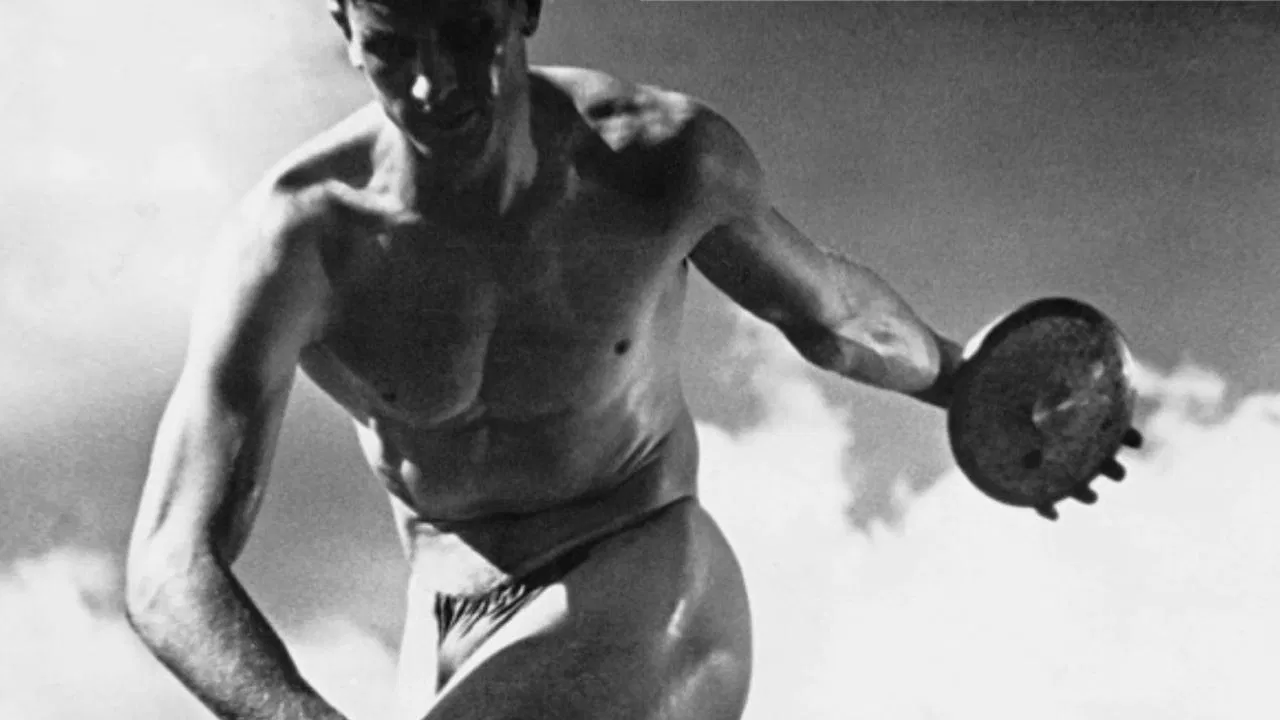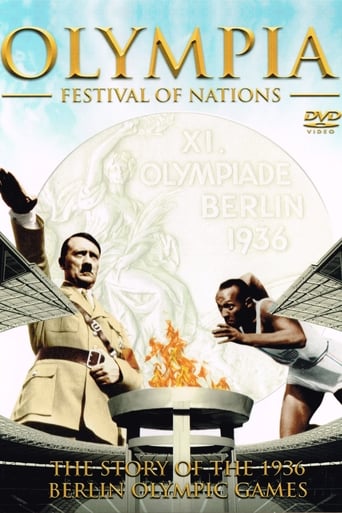


This is "Olympia 1. Teil - Fest der Völker", a German film from 80 years ago. The runtime stated here on IMDb is 2 hours 1 minute, but the version I watched was roughly 115 minutes long "only". The writer and director here is centenarian Leni Riefenstahl. At this point in her career, she had already stopped acting and produced some of the most infamous propaganda films in history. However, this documentary here is nothing like that. Like the title says, it is a celebration of all peoples. I personally felt it started a bit uninteresting, but when the introduction was over and the action moved to the actual event, the 11th Olympic Games from 1936 in Berlin, it gets a really great watch. For me, it was fun to see not only the athletes, but check their names on Google while watching and see what happened to them after the Games, during the war for example. I must say it is a bit disappointing how there is not such a documentary for all Olympic Games these days. The film is fairly neutral. It does show the German victories, but also shows for example the triumphs of African American athlete Jesse Owens, the biggest winner from the 1936 games probably. The documentary starts with the opening ceremony (not counting the prologue) and ends with the closing ceremony that follows the marathon event won by a Japanese athlete. Of course, we do not see Hitler applaud the foreign athletes, especially not the Black ones like Owens, but this would also have been really surprising. Germany wanted to prove themselves as open to the world (of sports), but that would have been too much. I believe this was a very good watch and all the original footage makes it a priceless historic document in terms of sports and politics. The only criticisms I could think of while watching was the lack of sports that weren't athletics, but I see Riefenstahl apparently covered that area in her second film on the subject. A must-see for every aspiring sports journalist. Highly recommended.
... View MoreThe bulk of the film is dry, sometimes dramatic sports coverage. It must have been spectacular at the time, remember this was the first time that millions of people all over the world had the chance to witness the Olympics on a screen, and the first time the Olympics were the kind of lavish spectacle we have now, but yes, this aspect of it is mostly dull. You have to appreciate why this is so; Riefenstahl practically invented sports coverage with this film, the angles, the slow motion (a favorite 'replay' shot), the panoramic aerial views, all of it is common vernacular these days. All of it frees the viewer from a fixed place in the audience and allows him to float, to survey. All of it comes from the cinema.No, if this is worth it, it's because of this woman. The debate continues unabated, morally complicit or not, but obscures a simpler truth: she was a fascist in the most pure, most artistic way possible, fascinated by strength, youth, harmony, disciplined body. I thrive in the exact opposite sensibility, but have to admire her conviction in bringing it all alive.She was a dancer before making her transition to film, and this is her dance film. All of her films are about choreographed sculpted form in motion and Part II of this is the most pure, but this is worth watching. You just need to see the opening and marathon sequence.Glistening bodies dance, contort, spin, writhe, glide. The camera dances. Her vision swirls, teases, dissolves in dreamlike flow. She's over the top trying to evoke this business of a beautiful spirit, but in the way dancers usually are, trying to act out feelings. It's beauty that borders on caricature. Near the end, we see marathon runners give up from exhaustion, but a young boy goes on steadfast. He runs shirtless, ergo the shot is staged and was not part of the marathon, staged to give a glimpse of the bare Ideal; the sculpted young body shining with perspiration. But it's a Latin boy of dark skin, which is perhaps Riefenstahl's fascism on the most simple level; nothing racial, just this near-comically spiritual libido for vigor.And something else. Following Riefenstahl's cinematic dance from one film to the next is a valuable exercise in itself.In Daus Blaue Licht, it was a dance between her as brave mountain climber that fate beckons to and a mystery that existed to unveil itself as refracted light from the heavens. The valley people were fearful and duplicitous. In Triumph, it was between herself and the people she sculpted to be the mountain, the mountain flattened before a master, the soul sculpted to be resolute, immovable.Here the body is free again, free within confines of the sport, the mood is solemn but spontaneous, the same with the people. Once more we descend from the skies to watch a show that celebrates virtue and power. But this is much more subtle than Triumph, this impression of spontaneity. The crowds cheer freely. Blacks win. Jesse Owens is shown several times and in closeup. The Germans win again and again, but only because they did. Others win. A Japanese man triumphs in the marathon. The American flag waves frequently. The Nazi flag much less so. The Fuhrer nods and claps, pleased with all. It's all about sports and people celebrating. It never feels like you're watching a state-sponsored film.Don't you see? Everything is fine in Nazi Germany, everything normal and civilized. The summer of the previous year had seen the Nuremberg Laws on German purity of blood. Nazi signs against Jews in '36 had been carefully removed in anticipation of visitors.The Nazis, masters of the sensual and overblown, invented the Olympic torch-relay for the Games. They made sure these were the first Games to receive televised coverage. They directly financed the film about them, a prestigious production. It was all staged for everyone to see the image they wanted to broadcast.The following year, Charlie Chan at the Olympics showed the shrewd detective helping out Berlin authorities against a ring of enemy spies. Nazi paraphernalia were carefully expunged from the picture. See, nothing was wrong in the country except enemy spies trying to steal a gizmo.
... View MoreThis is a documentary from the infamous German filmmaker/actress Leni Riefenstahl. Unlike her slobbery love letter to Hitler ("Triumph of the Will"), "Olympia Part One" and "Olympia Part Two" are surprisingly apolitical as well as exceptionally well made--both they don't make for the best viewing today.The film begins with its most famous scenes--nude actors doing various exercises. They are meant to be the ideals of beauty today--Germanic descendants of the original Greek athletes. Aside from a tiny loincloth covering the men, it's all nude--but not at all salacious. Instead, it comes off like an art film--and is AMAZINGLY artistic in style. You can tell Riefenstahl really made this project a labor of love with the camera-work and brilliant editing. This is why it took two years for the films to make it to German theaters--projects that were WAY overdue.What follows next is a straight retelling of the Berlin Olympics of 1936. The opening ceremonies are shown as are the track & field events--the rest of the events are shown in Part Two. While you do see several images of Hitler on screen and a few Germans in uniforms, these really were unavoidable considering this WAS Nazi Germany and Hitler was the head of state. But, victories by non-Germans and even Black-Americans are given the same screen time as those of Aryans--which really surprised me. This is especially surprising since the Germans actually won the most medals--but in watching the film you might just as soon have assumed the Americans did.On the downside, the film is dry--very dry. The narration is minimal--probably to make the film easier to market abroad. It really will bore the modern viewer to see most of these events. The only upside of this largest portion of the film is that occasionally the camera-work is absolutely brilliant--and better looking than more recent Olympic documentaries. The sum total effect is a film with great scenes and some amazing camera-work BUT will have LOTS of slow portions that haven't aged well because aside from Jesse Owens, you won't recognize anyone! Worth seeing once.
... View MoreSince the 1936 Olympics was pretty much one big propaganda event for Hitler-Germany, this documentary about it can also be seen as a piece of propaganda. You could say that it's just a recording of the event and it doesn't glorify Hitler and Nazism. It show a bit too much of Hitler and his friends than really necessary and it glorifies the German athletes more with its images than with most other athletes is the case. The 1936 were used as a medium to show the supremacy of the Aryan race and show the German athletes as Übermenschen.Besides being known as the Nazi-propaganda Olympics, the 1936 Olympics are of course also known as the Olympics of Jesse Owens. The black American who won 4 golden medals. A clear booing and whistling can also been heard during the first running that he won and during some of his other wins and attempts, while all other athletes got cheered at, no matter were they were from. This didn't only happened to Jesse Owens though, since he of course wasn't the only black athlete at the Olympics who won a medal.They didn't used only footage from the actual Olympics but some of the images were obviously added later into it. I'm not just talking about the movie its intro but also of the actual sporting events. This can be the drop of a spear or discuss and things like that. It's obvious that it's all added later and that the movie is edited in such a way that it's obvious that at times the crowd reactions and all don't really go with the images but for artistic reason it obviously works out well for the movie. It often gives the movie some diversity and more pace as well.The documentary shows the most important attempts and athletes and of course the wins of all events. It often uses multiple camera-angels for this and some slow-motion as well.There is no denying in it that Leni Riefenstahl was a very talented documentary maker though it of course it remains a shame that she mostly used her talent for making Nazi propaganda pieces, despite always having denied she was a Nazi sympathizer herself. It gives her documentaries a bit of a bitter taste, no matter how technical well made and revolutionary they all are. She gets very much appreciated and recognized as a pioneer in documentary making but she also gets hated at the same time. It doesn't really make her documentaries any less great to watch though. It's always something beautiful, renewing and just unforgettable.8/10http://bobafett1138.blogspot.com/
... View More